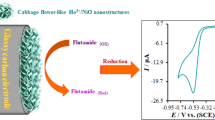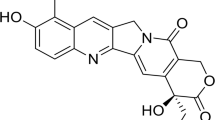Abstract
In the current study, a novel electrochemical sensor was constructed based on gold nanoparticles modified glassy carbon electrode (AuNPs/GCE) to detect Flutamide. Field emission scanning electron microscope was used to identify the morphology of the modified electrode. Cyclic voltammetry and differential pulse voltammetry (DPV) were used to investigate the electrochemical activity of the modified electrode. Flutamide concentration, pH, and scan rate were optimized as electrochemical parameters. Flutamide peak currents obtained by DPV were linear within the concentration range of 1–600 µM, and the detection limit was calculated as 1.5 nM. In addition, the fabricated electrochemical sensor was successfully employed to detect Flutamide in a cell culture media containing prostate cancer cells as the biological sample. The stability of the modified electrode within a day showed an appropriate precision.
Graphic abstract












Similar content being viewed by others
References
Temerk YM, Ibrahim HS, Schuhmann W (2016) Square wave cathodic adsorptive stripping voltammetric determination of the anticancer drugs flutamide and irinotecan in biological fluids using renewable pencil graphite electrodes. Electroanalysis 28(2):372–379
Temerk Y, Ibrahim H (2015) Electrochemical studies and spectroscopic investigations on the interaction of an anticancer drug flutamide with DNA and its analytical applications. J Electroanal Chem 736:1–7
Ahmadi F et al (2015) Synthesis of Ag nanoparticles for the electrochemical detection of anticancer drug flutamide. Chin J Catal 36(3):439–445
Brahman PK et al (2012) Voltammetric determination of anticancer drug flutamide in surfactant media at polymer film modified carbon paste electrode. Colloids Surf A 396:8–15
Rezaeifar Z et al (2018) Electrochemical determination of anticancer drug, flutamide in human plasma sample using a microfabricated sensor based on hyperbranchedpolyglycerol modified graphene oxide reinforced hollow fiber-pencil graphite electrode. Mater Sci Eng C 91:10–18
Karthik R et al (2017) A facile graphene oxide based sensor for electrochemical detection of prostate anti-cancer (anti-testosterone) drug flutamide in biological samples. RSC Adv 7(41):25702–25709
Neri R (1989) Pharmacology and pharmacokinetics of flutamide. Urology 34(4): 19–21
Kakutani N et al (2020) Evaluation of covalent binding of flutamide and its risk assessment using 19F-NMR. Xenobiotica 51:88–94
Núñez-Vergara LJ et al (2001) An electrochemical evidence of free radicals formation from flutamide and its reactivity with endo/xenobiotics of pharmacological relevance. Bioelectrochem 53(1):103–110
Sufrin G, Coffey D (1976) Flutamide. Mechanism of action of a new nonsteroidal antiandrogen. Invest Urol 13(6):429–434
Johnson DB, Sonthalia S (2019) Flutamide. StatPearls [Internet]. StatPearls Publishing, Treasure Island
Álvarez Lueje A et al (1998) Electrochemical study of flutamide, an anticancer drug, and its polarographic, UV spectrophotometric and HPLC determination in tablets. Electroanal Int J Devoted Fundam Pract Asp Electroanal 10(15):1043–1051
Ensafi AA, Khoddami E, Rezaei B (2016) Development of a cleanup and electrochemical determination of flutamide using silica thin film pencil graphite electrode functionalized with thiol groups. J Iran Chem Soc 13(9):1683–1690
Mutharani B, Ranganathan P, Chen S-M (2019) Chitosan-gold collapse gel/poly (bromophenol blue) redox-active film. A perspective for selective electrochemical sensing of flutamide. Int J Biol Macromol 124:759–770
El-Shanawany A et al (2014) Electrochemical characterization and determination of the anticancer drug, flutamide by cyclic voltammetry. Ann Chem Forsch 2:29–40
Pecková K et al (2012) Voltammetric determination of flutamide and its metabolite 4-nitro-3-trifluoromethylaniline at a hanging mercury drop minielectrode. Collect Czech Chem Commun 76(12):1811–1823
Zokhtareh R, Rahimnejad M (2018) A novel sensitive electrochemical sensor based on nickel chloride solution modified glassy carbon electrode for curcumin determination. Electroanalysis 30(5):921–927
Ezoji H, Rahimnejad M (2016) Electrochemical determination of bisphenol A on multi-walled carbon nanotube/titanium dioxide modified carbon paste electrode. Int J Sci Eng Res 7(6):242–246
Bard AJ et al (1980) Electrochemical methods: fundamentals and applications, vol 2. Wiley, New York
Yamazoe N (2005) Toward innovations of gas sensor technology. Sens Actuators B 108(1–2):2–14
Wilson DM et al (2001) Chemical sensors for portable, handheld field instruments. IEEE Sens 1(4):256–274
Brett CM (2001) Electrochemical sensors for environmental monitoring. Strategy and examples. Pure Appl Chem 73(12):1969–1977
Wang J (1991) Modified electrodes for electrochemical sensors. Electroanalysis 3(4–5):255–259
Murray RW, Ewing AG, Durst RA (1987) Chemically modified electrodes. Molecular design for electroanalysis. Anal Chem 59(5):379A-390A
Maduraiveeran G, Sasidharan M, Ganesan V (2018) Electrochemical sensor and biosensor platforms based on advanced nanomaterials for biological and biomedical applications. Biosens Bioelectron 103:113–129
Luo X et al (2006) Application of nanoparticles in electrochemical sensors and biosensors. Electroanalysis 18(4):319–326
Zen JM, Senthil Kumar A, Tsai DM (2003) Recent updates of chemically modified electrodes in analytical chemistry. Electroanalysis 15(13):1073–1087
Moniruzzaman M, Winey KI (2006) Polymer nanocomposites containing carbon nanotubes. Macromol 39(16):5194–5205
Durst R (1997) Chemically modified electrodes: recommended terminology and definitions (IUPAC Recommendations 1997). Pure Appl Chem 69(6):1317–1324
Kumar S et al (2015) Graphene, carbon nanotubes, zinc oxide and gold as elite nanomaterials for fabrication of biosensors for healthcare. Biosens Bioelectron 70:498–503
Dékány I (2011) Titanium dioxide and gold nanoparicles for environmental and biological application. Ann Faculty Eng Hunedoara 9(1):161
Boddu SR et al (2011) Gold, silver, and palladium nanoparticle/nano-agglomerate generation, collection, and characterization. J Nanopart Res 13(12):6591–6601
Elahi N, Kamali M, Baghersad MH (2018) Recent biomedical applications of gold nanoparticles: a review. Talanta 184:537–556
Li G, Miao P (2013) Theoretical background of electrochemical analysis. Electrochemical analysis of proteins and cells. Springer, Berlin, Heidelburg, pp 5–18
Laviron E (1979) General expression of the linear potential sweep voltammogram in the case of diffusionless electrochemical systems. J Electroanal Chem Interfacial Electrochem 101(1):19–28
Shetti NP et al (2009) Electrochemical oxidation of loop diuretic furosemide at gold electrode and its analytical applications. Int J Electrochem Sci 4:104–121
Hegde RN et al (2009) Electro-oxidation and determination of gabapentin at gold electrode. J Electroanal Chem 635(1):51–57
Kubendhiran S et al (2018) Innovative strategy based on a novel carbon-black− β-cyclodextrin nanocomposite for the simultaneous determination of the anticancer drug flutamide and the environmental pollutant 4-nitrophenol. Anal chem 90(10):6283–6291
Mehrabi A et al (2019) Electrochemical detection of flutamide with gold electrode as an anticancer drug. Biocatal Agricul Biotech 22:101375
Ding L et al (2007) A disposable impedance sensor for electrochemical study and monitoring of adhesion and proliferation of K562 leukaemia cells. Electrochem Commun 9(5):953–958
Chen H et al (2005) Detection of Saccharomyces cerevisiae immobilized on self-assembled monolayer (SAM) of alkanethiolate using electrochemical impedance spectroscopy. Anal Chim Acta 554(1–2):52–59
Funding
This study was funded by Babol Noshirvani University of Technology (Grant No. BNUT/370393/2020).
Author information
Authors and Affiliations
Corresponding author
Additional information
Publisher's Note
Springer Nature remains neutral with regard to jurisdictional claims in published maps and institutional affiliations.
Rights and permissions
About this article
Cite this article
Mehrabi, A., Rahimnejad, M., Mohammadi, M. et al. Electrochemical detection of Flutamide as an anticancer drug with gold nanoparticles modified glassy carbon electrode in the presence of prostate cancer cells. J Appl Electrochem 51, 597–606 (2021). https://doi.org/10.1007/s10800-020-01519-9
Received:
Accepted:
Published:
Issue Date:
DOI: https://doi.org/10.1007/s10800-020-01519-9




